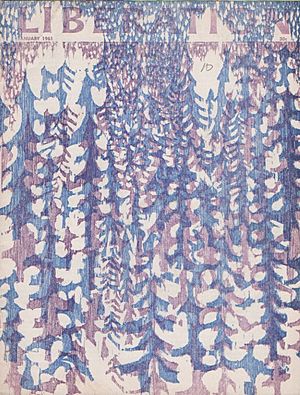Liberation (magazine) facts for kids
 |
|
| First issue | April 1956 |
|---|---|
| Final issue | 1977 |
| Based in | New York City, New York, U.S. |
| Language | English |
| ISSN | 0024-189X |
| OCLC | 856110 |
Liberation was an important magazine published in the United States from 1956 to 1977. It was a pacifist magazine, meaning it promoted peace and was against war. At first, it came out every two months, then it became a monthly magazine. In the 1960s, Liberation was known for supporting the New Left movement. This movement included groups that wanted big changes in society and politics.
Contents
The Story of Liberation Magazine
Liberation magazine was started by a group of people who believed in peace and social change. These founders included David Dellinger, Bayard Rustin, Sidney Lens, Roy Finch, and A. J. Muste. They published the magazine from offices in New York City and Glen Gardner, New Jersey.
Starting the Magazine
A. J. Muste helped get money for the magazine from the War Resisters League. This group works to end war. Bayard Rustin spent a lot of time and effort on Liberation. He helped raise money and met weekly with Muste. Rustin even wrote to Martin Luther King Jr., who later wrote articles for the magazine.
The very first issue of Liberation: An Independent Monthly came out in April 1956.
Important Articles and Ideas
Liberation magazine shared some ideas with other important journals like Dissent. The magazine supported the Cuban Revolution, which was a big political change in Cuba. It also published a famous article called "Listen, Yankee!" by C. Wright Mills.
David Dellinger, one of the editors, supported the Cuban government led by Fidel Castro. This caused some disagreement at the magazine. Roy Finch, a philosophy professor and editor, decided to leave because of this.
Liberation also strongly supported groups like Students for a Democratic Society. This student group worked for peace and social justice. The magazine was also very much against the Vietnam War. They published many articles explaining why the war was wrong.
Helping Activists
The magazine worked closely with organizers from the Fellowship of Reconciliation (FoR). This group also promotes peace and non-violence. Sometimes, the offices of Liberation even served as a place where activists could share information. These activists were working on non-violent resistance, which means protesting without using violence.
Special Investigations
Liberation sometimes published special articles that looked deeply into important issues. These were like detective stories for news. For example, in 1965, the magazine published articles by Vincent Salandria. These articles questioned the findings of the Warren Commission. This commission had investigated the assassination of President John F. Kennedy.
Later, in 1975, Liberation published an article by Fred Landis. This article discussed how the CIA used special tactics in Chile.
Art and Poetry
Many of the magazine's covers featured artwork by children's book author Vera Williams. A poem by Louis Ginsberg, who was the father of famous poet Allen Ginsberg, was also published in the magazine.
The End of Publication
By 1977, Jan Edwards and Michael Nill were editing the magazine from Cambridge, Massachusetts. Liberation stopped being published not long after David Dellinger left the magazine.
In 1965, a collection of articles from Liberation was put into a book called Seeds of Liberation. It was edited by Paul Goodman.
Why Liberation Magazine Was Important
Liberation magazine, along with Dissent, helped show what was coming next for political groups in America in the 1950s. They were early supporters of the Civil Rights Movement, which worked for equal rights for all people. They also promoted the idea of nonviolent protest, which became a very important way for people to bring about change.

